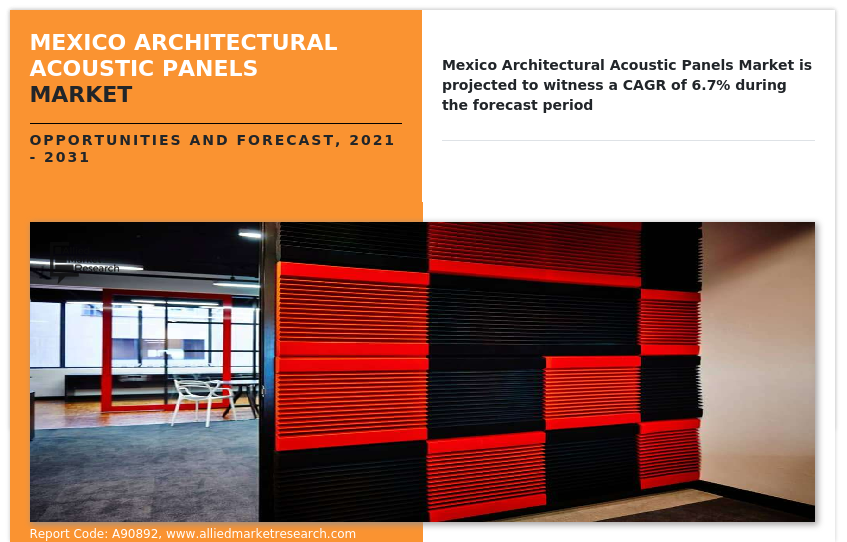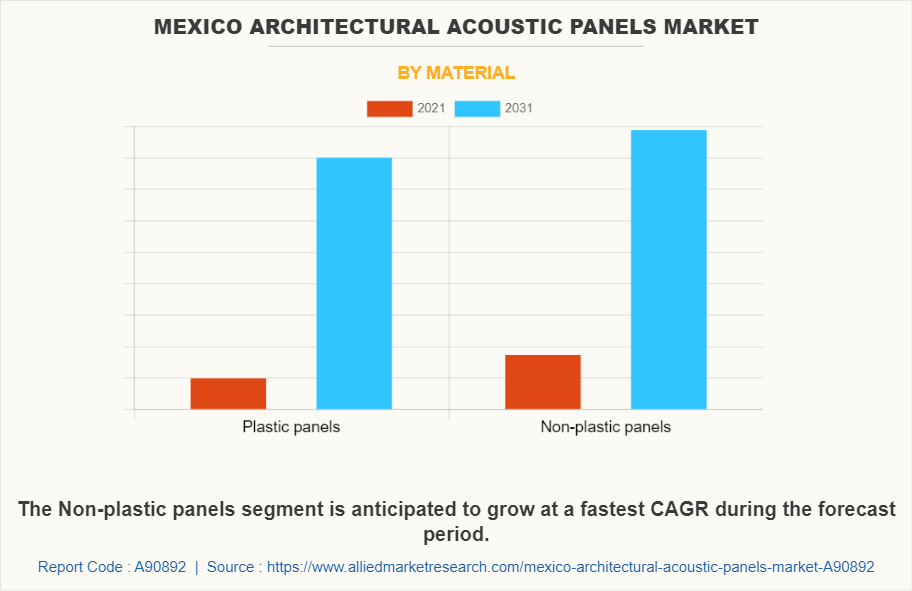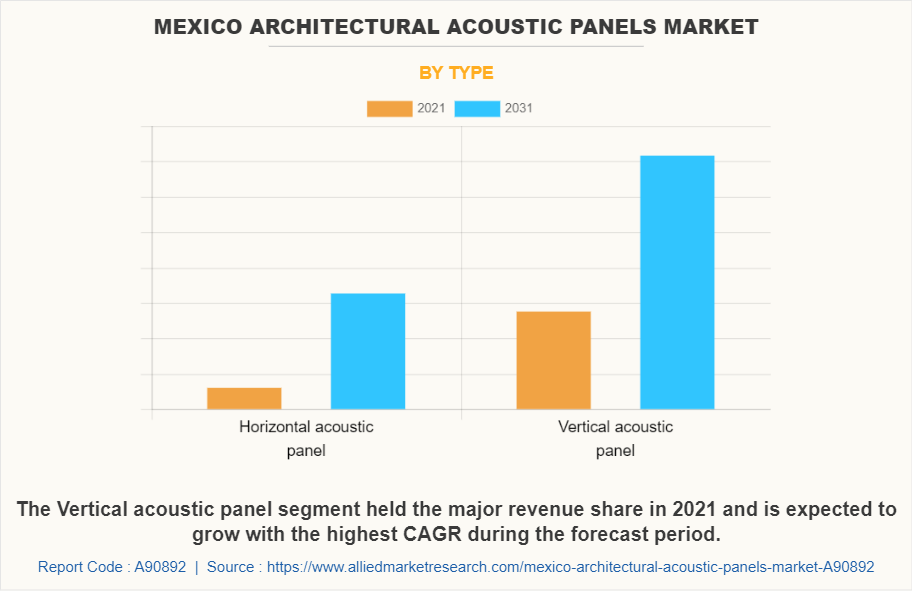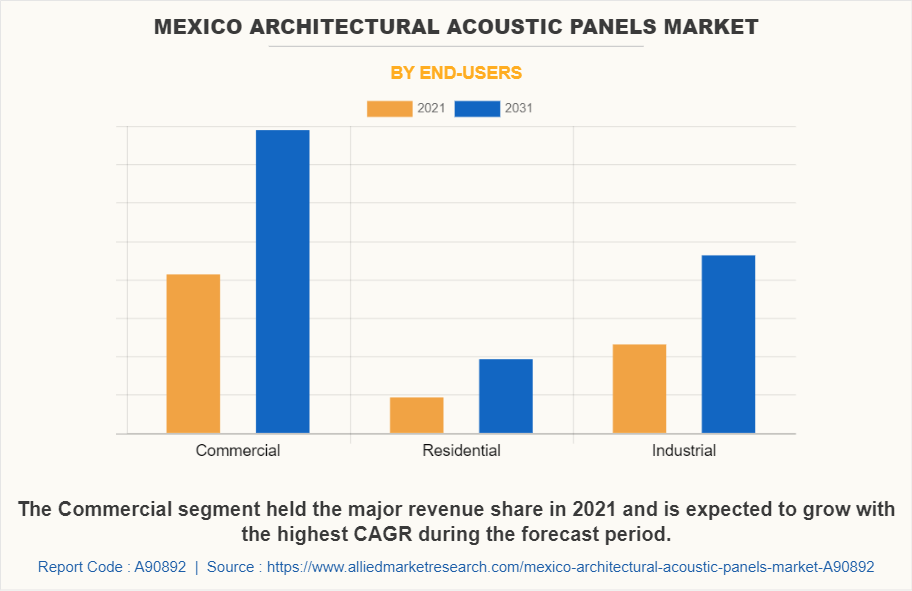The Mexico architectural acoustic panels market has witnessed substantial growth during the projection period. Industry is propelled into the future by market driving forces, which encompass rise in the awareness of the significance of acoustics in diverse spaces such as commercial, residential, and industrial settings. The demand to establish acoustically pleasing environments has become increasingly evident, prompting architects and interior designers to seek out inventive solutions. Furthermore, the market's growth potential is enhanced by strict noise regulations and increase in appreciation for the role of acoustic panels in mitigating noise pollution.

On the other hand, market restraints hinder the progress of the sector by acting as counterforces. An instance of such a restraint is high initial cost linked to the installation of acoustic panels. Nevertheless, it is important to bear in mind that these panels frequently lead to long-term cost savings by enhancing energy efficiency and boosting employee productivity. In addition, another restraint relates to the difficulties encountered in achieving visually appealing designs with acoustic panels. Finding the right balance between form and function is puzzling, and investigation is required in this regard.

However, the market offers several opportunities, including progress for innovation. With the continuous advancement of materials and design techniques, new and improved acoustic panels are developed. In addition, rise in the demand for environmentally friendly solutions presents a significant opportunity for the adoption of sustainable materials in acoustic panels. By utilizing recycled or biodegradable materials, architects and designers align with the sustainability movement while still achieving their acoustic goals.

The Mexico architectural acoustic panels market is segmented into material, type, and end user. Depending on material, the market is bifurcated into plastic panels and non-plastic panels. Plastic panels, despite their cost-effectiveness, frequently give rise to apprehensions regarding sustainability and environmental consequences. Conversely, non-plastic panels present eco-friendly alternatives with different levels of acoustic efficacy. The complexity of this sector is compounded by the assortment of non-plastic materials, such as wood, fabric, and mineral wool, each possessing distinctive acoustic characteristics and aesthetic allure.
By type, it is classified into horizontal acoustic panel and vertical acoustic panel. Ceiling applications commonly utilize horizontal panels due to their sound reflection capabilities, while vertical panels are often preferred for walls as they possess superior sound absorption characteristics. The selection between these two types is contingent upon the specific acoustic needs of a particular space.

On the basis of end user, the market is segregated into commercial, residential, and industrial. Acoustic solutions are essential in various settings to improve the comfort and tranquility of individuals. Commercial spaces, such as offices, restaurants, and shopping malls, require effective acoustic measures to cater to the needs of both patrons and employees. Similarly, homeowners in residential settings are increasingly opting for acoustic panels to establish peaceful and serene living environments. On the other hand, industrial spaces, including factories and warehouses, have distinct acoustic requirements that involve minimizing the noise produced by heavy machinery and industrial processes.
Market players are investing in R&D to create products that offer improved sound performance, visual appeal, and environmental sustainability. The integration of advanced materials and manufacturing techniques holds the potential to transform the industry. Moreover, pricing strategies add an additional layer of complexity to this intricate landscape. Market players employ diverse pricing strategies to cater to various segments and meet the diverse needs of consumers. While some choose premium pricing to position their products as high-end solutions, others embrace competitive pricing to tap into a wider market. In addition, pricing environment is complicated by varying costs associated with different materials, manufacturing processes, and customization options.
A comprehensive understanding of the Mexico architectural acoustic panels market is gained through a SWOT analysis. This analysis sheds light on the internal and external factors by examining the strengths, weaknesses, opportunities, and threats facing the market. Significantly, strengths include rise in the awareness of significance of acoustics in various settings, availability of a diverse range of materials and designs to cater to different aesthetic and acoustic requirements, and surge in the adoption of sustainable materials in response to environmental concerns. On the other hand, weaknesses include high initial cost associated with the installation of acoustic panels, challenge of creating aesthetically pleasing designs with these panels, and dependence on specific suppliers for high-quality materials.
However, there are opportunities for innovation in materials and design to meet evolving customer demands, integration of smart technology into acoustic panels for real-time adjustments, alignment with stringent noise regulations to meet compliance and market demand. It is important to be aware of potential threats such as substitute products or services in the broader acoustic solutions market, intense competitive rivalry requiring constant innovation and differentiation, and economic fluctuations that impact construction and renovation projects.
Key players operating in the market are Knauf Insulation, Armstrong World Industries, Inc., Saint-Gobain Group, USG Corporation, G&S Acoustics, Decustik, RPG Acoustical Systems LLC, Vicoustic, Pyrok, Inc., and Texaa.
Key Benefits For Stakeholders
- Enable informed decision-making process and offer market analysis based on current market situation and estimated future trends.
- Analyze the key strategies adopted by major market players in Mexico architectural acoustic panels market.
- Assess and rank the top factors that are expected to affect the growth of Mexico architectural acoustic panels market.
- Top Player positioning provides a clear understanding of the present position of market players.
- Detailed analysis of the Mexico architectural acoustic panels market segmentation assists to determine the prevailing market opportunities.
- Identify key investment pockets for various offerings in the market.
Mexico Architectural Acoustic Panels Market Report Highlights
| Aspects | Details |
| Forecast period | 2021 - 2031 |
| Report Pages | 73 |
| By Material |
|
| By Type |
|
| By End-users |
|
| Key Market Players | DEACERO INALAMBRICO, ARINCAK Acoustic panel, Acoustica Sonora, BHARATI METALS, Pacor Inc., Sistemas Acústicos S.A. de C.V., SONORRUEDA, ALMO Acoustical, TENDO, Tectonico |
The Mexico Architectural Acoustic Panels Market is projected to grow at a CAGR of 6.7% from 2021 to 2031
Knauf Insulation, Armstrong World Industries, Inc., Saint-Gobain Group, USG Corporation, G&S Acoustics, Decustik, RPG Acoustical Systems LLC, Vicoustic, Pyrok, Inc., and Texaa are the leading players in Mexico Architectural Acoustic Panels Market
Enable informed decision-making process and offer market analysis based on current market situation and estimated future trends. Identify key investment pockets for various offerings in the market.
Mexico Architectural Acoustic Panels Market is classified as by material, by type, by end-users
Loading Table Of Content...
Loading Research Methodology...



